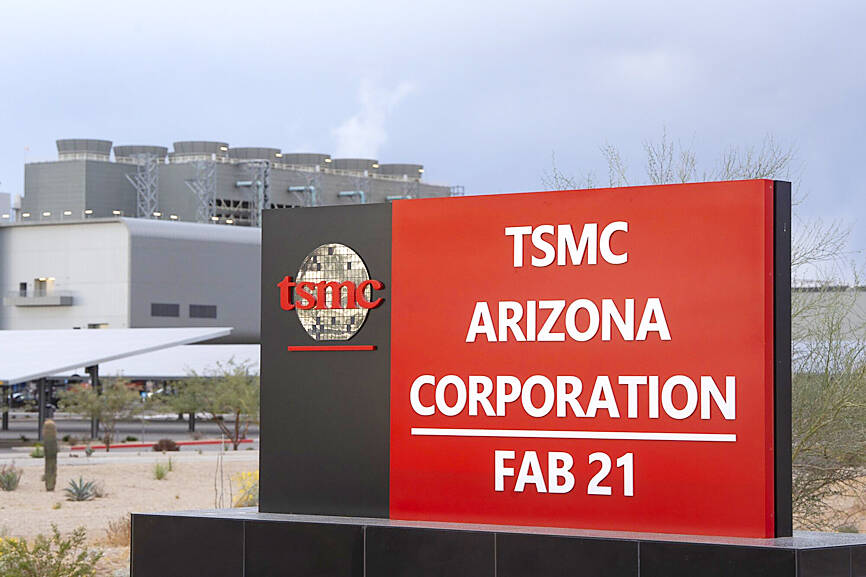Taiwan Semiconductor Manufacturing Co’s (TSMC, 台積電) plan to increase its investments in the US by US$100 billion would provide the company with long-term strategic advantages, researchers said on Wednesday.
Taiwan Ratings Corp (中華信評) said that TSMC’s investment plan — if implemented successfully — would help the company “reduce the risk of its assets being concentrated in Taiwan over the long term.”
Such a strategy would “alleviate geopolitical and trade policy risks,” the ratings agency said in a report, alluding to potential tariffs that many fear Washington could levy against Taiwan’s domestic chip industry.

Photo: Bloomberg
The report said that even if TSMC’s capital expenditure increases to US$50 billion to US$55 billion per year from this year to 2027, the most valuable company on the local stock exchange “should still be able to maintain a net cash position supported by strong profitability and operating cash flow.”
However, according to Taiwan Ratings’ parent company, S&P Global Co, TSMC’s new production capacity in the US would take longer to achieve profitability than if such capacity was built in Taiwan.
US President Donald Trump and TSMC chairman C.C. Wei (魏哲家) on Monday jointly announced that the Taiwanese chip manufacturer would invest the 12-figure sum to build facilities, including three wafer fabs and two advanced packaging plants in the US.
TrendForce Corp (集邦科技) said that even if TSMC’s US$100 billion investment goes smoothly, the planned fabs would “enter mass production after 2030 at the earliest.”
Although TSMC’s production capacity in the US could reach 6 percent by 2035, its production capacity in Taiwan would remain at or above 80 percent, the Taipei-based market researcher said in a separate report.
TrendForce emphasized that TSMC’s latest investment pledge is a continuation of a longer-term trend in the company’s supply chain differentiation strategy.
The Taiwanese chip behemoth accelerated this strategy after 2018 due to factors including “global trade disputes” and the COVID-19 pandemic, which persuaded governments worldwide to seek to build production capacity in semiconductor technologies in local markets, the report said.
However, TSMC’s plan to expand its investment in the US would contribute to a decline in Taiwan’s dominance of the global chip industry over the next five years, the report said.
Taiwan held a 71 percent global market share in the production of advanced processes and 53 percent for mature processes in 2021, but that would drop to 58 percent and 30 percent respectively by 2030, TrendForce said.

SELL-OFF: Investors expect tariff-driven volatility as the local boarse reopens today, while analysts say government support and solid fundamentals would steady sentiment Local investors are bracing for a sharp market downturn today as the nation’s financial markets resume trading following a two-day closure for national holidays before the weekend, with sentiment rattled by US President Donald Trump’s sweeping tariff announcement. Trump’s unveiling of new “reciprocal tariffs” on Wednesday triggered a sell-off in global markets, with the FTSE Taiwan Index Futures — a benchmark for Taiwanese equities traded in Singapore — tumbling 9.2 percent over the past two sessions. Meanwhile, the American depositary receipts (ADRs) of Taiwan Semiconductor Manufacturing Co (TSMC, 台積電), the most heavily weighted stock on the TAIEX, plunged 13.8 percent in

A wave of stop-loss selling and panic selling hit Taiwan's stock market at its opening today, with the weighted index plunging 2,086 points — a drop of more than 9.7 percent — marking the largest intraday point and percentage loss on record. The index bottomed out at 19,212.02, while futures were locked limit-down, with more than 1,000 stocks hitting their daily drop limit. Three heavyweight stocks — Taiwan Semiconductor Manufacturing Co (TSMC, 台積電), Hon Hai Precision Industry Co (Foxconn, 鴻海精密) and MediaTek (聯發科) — hit their limit-down prices as soon as the market opened, falling to NT$848 (US$25.54), NT$138.5 and NT$1,295 respectively. TSMC's

TARIFFS: The global ‘panic atmosphere remains strong,’ and foreign investors have continued to sell their holdings since the start of the year, the Ministry of Finance said The government yesterday authorized the activation of its NT$500 billion (US$15.15 billion) National Stabilization Fund (NSF) to prop up the local stock market after two days of sharp falls in reaction to US President Donald Trump’s new import tariffs. The Ministry of Finance said in a statement after the market close that the steering committee of the fund had been given the go-ahead to intervene in the market to bolster Taiwanese shares in a time of crisis. The fund has been authorized to use its assets “to carry out market stabilization tasks as appropriate to maintain the stability of Taiwan’s

STEEP DECLINE: Yesterday’s drop was the third-steepest in its history, the steepest being Monday’s drop in the wake of the tariff announcement on Wednesday last week Taiwanese stocks continued their heavy sell-off yesterday, as concerns over US tariffs and unwinding of leveraged bets weighed on the market. The benchmark TAIEX plunged 1,068.19 points, or 5.79 percent, to 17,391.76, notching the biggest drop among Asian peers as it hit a 15-month low. The decline came even after the government on late Tuesday authorized the NT$500 billion (US$15.2 billion) National Stabilization Fund (國安基金) to step in to buoy the market amid investors’ worries over tariffs imposed by US President Donald Trump. Yesterday’s decline was the third-steepest in its history, trailing only the declines of 2,065.87 points on Monday and